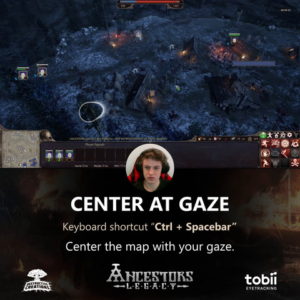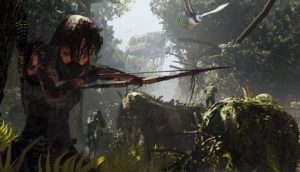Summary and detailed design guidelines of explored eye tracking features

The explored features we have integrated in many games are categorized between visuals, UI interaction and game mechanics. The features have evolved under the condition the game was not designed from the start involving eye tracking. So, the feature set it is not complete, more awesome features awaits to be explored.
These features change the presentation of the game world to the user, which means a user will get an enhanced sensation of visually perceiving the world. Eye tracking can assist in providing an aesthetic tone and style of the game by rendering the world in specific ways based on where you look. A couple of emotions this category can elicit are presence and immersion.
Extended View – Directs the in-game camera to rotate or orbit depending on your head rotation and gaze point position on the screen, automatically moving what you want to look at into view.
Dynamic Light Adaptation – When the human eye moves between areas of different amounts of light exposure, the scene illumination responds and adapts.
Clean UI – HUD Elements such as mini-maps, health and ammo bars can be faded out and transparent when not looked at, keeping the screen clean from unnecessary items.
Dynamic Depth of Field – Alters the focus depth dependent on where you look in the scene.
When players want to perform an action, th ese eye tracking features accurately reflect the players intentions. This category make use of the modality of eye tracking to smooth up ways how you interact with the game. When your hands are tied up to other input controllers, such as with mouse, keyboard and gamepad, you can plan and execute your selection with help from your attention.
ese eye tracking features accurately reflect the players intentions. This category make use of the modality of eye tracking to smooth up ways how you interact with the game. When your hands are tied up to other input controllers, such as with mouse, keyboard and gamepad, you can plan and execute your selection with help from your attention.
Menu Navigation – Select an item from the menu with your eyes.
Zoom/Bungee Zoom – Zoom in on position currently look at. With Bungie zoom, do this momentarily.
Wheel Menu – Swiftly choose an item from the wheel menu with your eyes.
Center at Gaze – center the screen on looked spot.
Auto Pause – When the eye tracker detects no user in front of screen the game goes into pause mode.
Where I look is relevant to the gameplay in a meaningful way. This category extends agency in the game, i.e. the ability of a player to interact meaningfully with the game world. This category is important for a successful integration of eye tracking in a game as the emotions elicited can be engagement, meaningfulness, empowerment, and awareness.
Teleport, Jump and Cover at Gaze – Move yourself or your avatar according to your intentions by simply looking at the target position.
Aim at Gaze – The aim and crosshair snap to where I look.
Select at Gaze – Select objects by simply looking at then.
Throw at Gaze – Control your throwing by looking at the landing spot.
Fire at Gaze – Fire weapons to the spot you look at.
Flashlight Control – Direct the flashlight by looking around in the scene.
Environment/Object Awareness – The environment and objects in the game world responds when looking at them.
Character Awareness – A character in the game responds to your gaze to deepen the social interaction.


